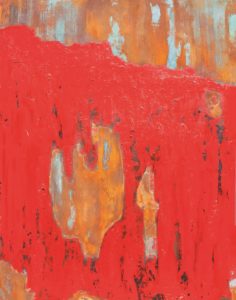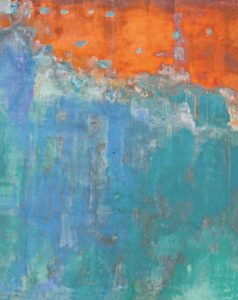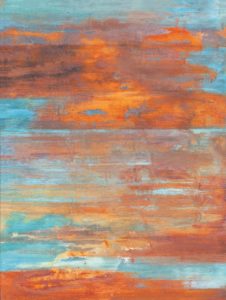
“I have always been moved by the structures of home,” says artist Willie Little, who grew up in North Carolina. “The metal tobacco barns, regular barns, things that are just falling down. I love the formations of rust. The red and the rust, the aluminum silver color, and the way the shapes run because of the passage of time, and what the elements did to it. Sometimes it looks like a topographical map.”
Little is speaking from his studio in Oakland, Calif., where he was mostly quarantined during the pandemic. “I was able to make a lot of work, and go through a lot of emotions, because of the kind of work I do,” he says. “As a Black gay man, a lot of my work relates to social justice and Black Lives Matter.”
Little works across several media — painting, sculpture, installation, and the written word. His show of new abstract paintings at Rice Polak Gallery, alongside works by Bruce Ackerson, Peter Arvidson, and Mike Stilkey, opens Thursday, July 22 and runs through Aug. 4.
On the surface, Little’s paintings are handsome abstractions of deep, pungent color — rusty red and burnt orange, tempered by sky blue. They’re mixed-media triumphs of oxidation — oil paint and wax medium on large wood panels sturdy enough to bear heavy, textured layers. In paintings such as Red Ridge, the scale and beauty pull you in, but the message beneath the surface is as strong as the color.

“It started off being an escape, because it is beautiful, but it’s also inspired by where I come from,” says Little. “We lived on this little farm, and my father had a grocery store that was an illegal liquor house. We were poor. I had this affinity for all the things that most people would think would be horrible about my childhood: a falling-down fence, a rickety window, peeling paint.”
Little — who published a memoir, In the Sticks, in 2019 — was raised by his aunt, who he thought was his mother until he was six. “My early work was all about making sense out of who I am, and where I come from,” he says. “It comes from my love for decay — my aesthetic for the passage of time.” This aesthetic is evident in his recent work, he says, with surfaces riddled with scars and layers of history.
“Especially this time, I couldn’t help but put the feeling into the work — the gouging, and getting frustrated with it because I’m so tired, ” he says, citing James Baldwin and George Floyd in the same breath. “I love all things that are aging. There’s beauty in that, but there’s also ugliness in the eroding of spirit because of the horrible history of America.” A fearlessness pervades Little’s work — his message is carried on a wave of urgency.
Determination got Little out of the sticks when he pursued a B.A. from the University of North Carolina at Chapel Hill. He then settled in Charlotte, N.C. for 18 years, always hiding his sexuality. “Many times, I would diffuse my light and not want to be seen, or not want to be ridiculed for any femininity, because that is so taboo, especially for a Black man in the rural South.” He moved to San Francisco in 2002.

Little began what he calls the “oxidation paintings” in 1999, after he mistakenly stumbled upon the effects of oxygen, heat, and water on bronze and copper medium, which he began to incorporate with oil paint and wax. Like an alchemist, he adds copper sulfate and ammonium chloride to liquid iron to make it rust. The result is a catalogue of complex colors: deep oranges in paintings such as Rusty Fog, a balm of soft cool blues in Tahoe So Blue, but the preponderance of red is the most significant.
“Red adds so much,” says Little. “It’s an undeniably beautiful color — an emotional color that also says, ‘See me! I will not be denied!’ It’s the color of blood, of bloodshed — the blood shed by my people at the hands of gun violence.”
Little considers himself a “cultural worker surveilling everything I see and documenting it.” He wants his work to look like it was “unearthed from an archeological dig.” Though Little’s work is beautiful, “some of the subject matter is ugly,” he says. “It’s all about seducing the audience with its beauty.”

The flipside meaning of the color red is, of course, love. Despite his trauma and violent past, Little’s work still looks towards hope and redemption founded on love. “There’s a trend toward having work that is more affirming, more positive, and more hopeful,” he says. “That’s why my work is the way it is. It is the rural aesthetic — earthy, real, raw.
“I’m always trying to prove something to myself,” says Little, “because I am not that little country boy — though I still am! As soon as you claim everything about yourself, you can’t be ashamed of it. That’s why I love talking about all the ugliness — and the beauty — of who I am and where I came from. No shame.”
The Rest Is Rust
The event: A show of works by Willie Little
The time: Thursday, July 22 to Aug. 4; opening reception Friday, July 23 from 7 to 9 p.m.
The place: Rice Polak Gallery, 430 Commercial St., Provincetown
The cost: Free
